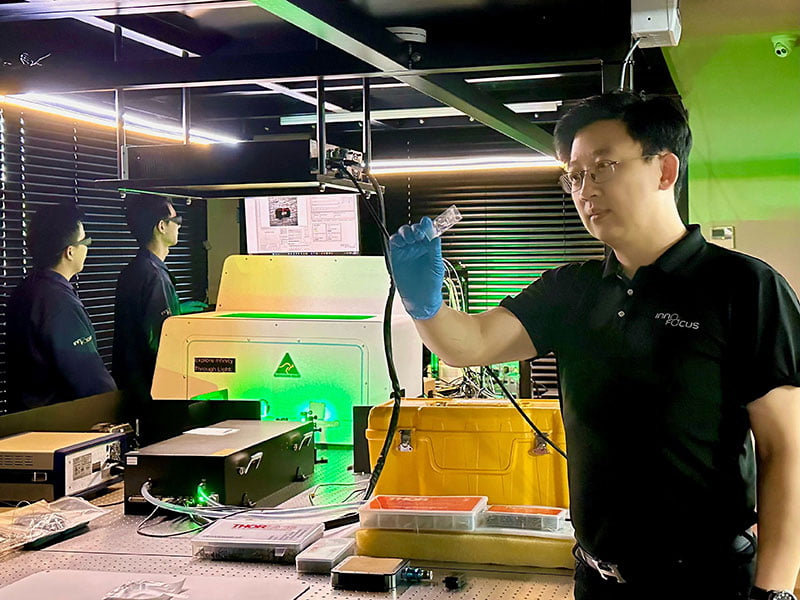“Shaping the future of quantum technologies” is how Frank Yao describes the role of Innofocus’s newly minted 1,000 square metre nanofabrication hub in Melbourne.
His team is on a mission to manufacture the precise materials and devices vital for quantum technology’s molecular hardware.
“With photonics ushering in high-speed, energy-efficient, and cool-running technologies, its potential for next-generation optical and quantum computing is immense,” Mr Yao said.
Bang in the middle of Melbourne’s vibrant innovation ecosystem, the hub aims to be a magnet for scientists, industry leaders, and government officials, fostering collaboration and innovation.
In a deep dive conversation with InnovationAus.com editorial director James Riley, Mr Yao warns of the “need to break free from the physical limitations of silicon-based nanostructured materials within the next five years.”
Initially self-funded, Innofocus achieved a significant milestone by developing the world’s first commercialised, intelligent, automated laser nanofabrication equipment. “Our technology touches everything — electronics, healthcare, energy, agriculture, MedTech, and more, making it the holy grail of advanced manufacturing.”
It’s been a challenging, inspirational journey for the founder, who worked for global tech giants like Motorola before firing up his Melbourne-based startup in 2018.
His team has used the challenges brought by the pandemic to catalyse new research and development into laser nanofabrication systems, which has found the company buyers in Singapore, the US, India, Australia, and China.
“This success spurred us to develop new products and explore new materials,” Mr Yao said. Use cases of their technology reach into medical devices, communication, sensing, cooling systems, smart farming, and anti-counterfeiting solutions.
“With Moore’s Law nearing its endpoint, we’re on the brink of a major shift,” he said.
Today’s manufacturing — cutting, welding, 3D printing — reshapes materials.
“But our photonics-based nanomanufacturing,” Mr Yao continues, “introduces two or three-dimensional purposely-designed nanostructures into any material, creating new material properties.”
Exploring venture capital and government funding options for his atomic-scale operations requires careful gap analysis and education to help decision-makers understand the value proposition and future payoff.
He plans to use the facility to demonstrate nano-tech to public, helping them understand and appreciate the innovations that could “make Australia the world leader in nanomanufacturing”.

By all accounts, he is on the right track, with four Nobel Prizes in Physics over the past 20 years in the ultrafast laser area, closely related to the work Innofocus is doing in nanomanufacturing.
Before launching his company, the tech existed only in research institutes for niche purposes. “There was no easy-to-use commercialised equipment to fabricate large areas of devices or materials with nanometer precision. That was the spark for us,” Mr Yao said.
As the nano-hub expands its influence in Melbourne, it will require continuous financial injections to sustain and grow its R&D efforts and operations in line with all similar deep tech ventures.
Mr Yao’s team has already garnered several accolades, boosting their confidence and reinforcing their mission and ability to attract capital, including being named among the ’20 Most Promising Australian Tech Companies of 2023′.
Innofocus was a finalist in the 2021 Australian Tech23 Gamechanging Company, a runner-up in the 2022 Australian Technologies Competition Awards, a consecutive winner of the Australian Made Awards in 2022 and 2023, a finalist in the Engineers Australia 2022 Victoria Excellence Projects Awards, and the Winner of the 2023 Australian Innovation Competition.
“We’re at a crucial juncture regarding funding,” he concedes, “essential for both widening our industry reach and scaling up our operations, especially as a capital-intensive R&D company.”
Mr Yao’s dream of turning flat two-dimensional tech into three-dimensional wonders is gaining traction in Melbourne. In the coming years, he hopes to build more intelligent machines that make this possible, merging fields like AI and engineering to solve problems in fields like quantum computing.
“It’s all about taking this technology to the next level,” he said.
This article was produced by InnovationAus.com in partnership with Innofocus.
Do you know more? Contact James Riley via Email.
